Please use the following link to download the February 18, 2023 issue of the syəcəb
Extended Foster Care – What is it, and how is it helping youth
Submitted by beda?chelh Leadership
When beda?chelh youth are set to turn 18 and age out of foster care, they become eligible for a voluntary program offered by the State of Washington called Extended Foster Care (EFC). This collaborative partnership between the Tribes and the State ensures youth aging out of foster care are able to transition to independence at their own pace. While this could look different for each youth, the idea is to help them successfully transition to independence and self-sufficiency.
Youth who participate in EFC can choose to remain with their placement until age 21 or choose a different independent living option while continuing to receive support services that would typically end when they turn 18. These services can help youth successfully transition to independence. Support services include:
- A monthly stipend to help towards living expenses
- Support with placement options, such as Independent Living
- Transition planning support
- Accessing community resources
- Help locating service providers and setting up appointments
- Resume building and job searches
Youth can focus on finishing high school, entering college, learning a trade, entering employment, or any activity that helps to remove barriers to independence. Youth in EFC are also responsible to stay in contact with their social worker monthly. To be eligible for EFC, youth must engage in one of the participation requirements. These include actively working on at least one of the following categories:
- Enrolled in high school or GED program
- Applied for or enroll in college or a vocational program;
- Participation in a program or activity designed to promote or remove barriers to employment;
- Working 80 hours or more a month
While participants can remain in EFC the entire time from ages 18-21 years old participation in the program is flexible, allowing youth to enter and exit as needed until age 21. This allows particiapnts to receive assistance in a manner that meets their individual needs. beda?chelh has been excited to see the progressive growth of the EFC program with 18 youth currently enrolled in EFC.
Hibulb diversifies kids’ knowledge through crafts
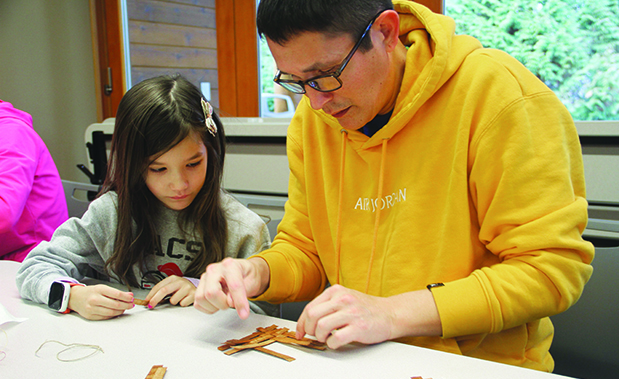
By Shaelyn Smead, Tulalip News
On February 11th, like many other weekends at the Hibulb Cultural Center (HCC), the classrooms were occupied with invested patrons looking to learn and understand aspects of Native culture. One of the classes consisted of a kids’ craft, creating a heart necklace made of cedar.
The Hibulb enriches the lives of visitors through demonstrations, workshops, cultural presentations, and lectures. But the kids’ crafts can reach new audiences: families.
Museum Assistant Braxton Wagner, who taught the class that day, said, “It is so much fun working with kids. I love to see their limitless creativity and their curiosity flourish. They can be so sweet. I feel like kids are so open and receptive to learning about different cultures and experiences of other people, and these classes are a great opportunity to teach them.”
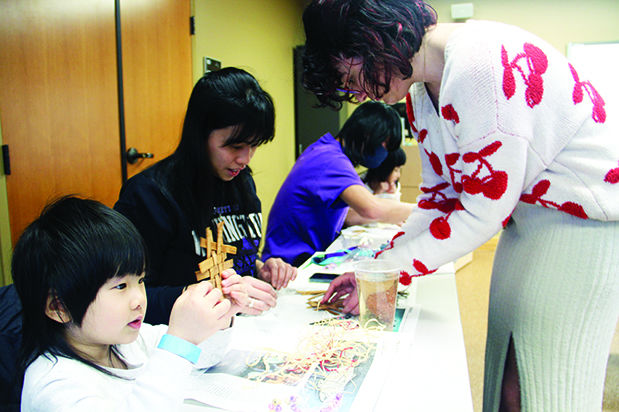
A diverse gathering of parents and their children joined the class, where they each received a bag of cedar strips and other materials to make the cedar-woven heart necklace. The kids’ crafts typically are simple activities that they can finish together as a family within an hour or so. By extending out to families, projects like these can diversify kids’ knowledge about the many communities surrounding them and expose them to new cultures.
When the families weren’t concentrating on the cedar project, kids played, and parents exchanged stories and smiles with each other. One of the parents in attendance was a Ph.D. candidate University of Washington Law and Indigenous Taiwanese citizen Margaret Tu (Nikal Kabala’an). Along with her studies of Indigenous peoples, Margaret has begun her travels across Washington to immerse herself in the culture of local tribes.
Margaret spoke about the beauty of Indigenous communities connecting, “We all have faced similar struggles. Colonization, forced relocation, laws around our language and culture, etc. But we also know the fight that we have for our people and cultural preservation. I hope to learn from the Indigenous communities around here, see what has been successful for them, and take that back to my people.”
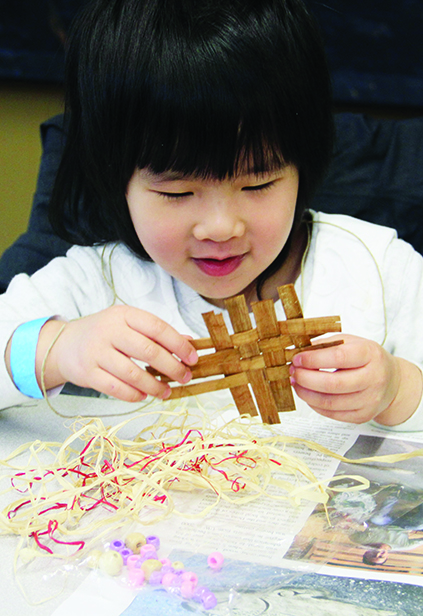
She found it necessary to bring her kids along in her journey and attend the class, saying, “We don’t have this opportunity in Taiwan to connect with other Indigenous communities. There’s a cultural revitalization movement around us, and I want my kids to be a part of it. So I think exposing them to these educational and learning opportunities while we’re here is important. I know they enjoyed it.”
Studies have found great value in establishing diverse environments for youth. In 2019, the Michigan Association for Infant Mental Health stated, “We tend to assume that inclusion alone creates respect for differences. However, it is active conversation and support for children’s understanding of diversity that guards against the development of the stereotypes and prejudice that contribute to biased behavior”.
Simple one-hour classes like these provide new exposure, conversations, and knowledge of our people and culture.
For more information about HCC classes and events, visit their website at: www.hibulbculturalcenter.org/Events.
The Cupid Shuffle
Education Division shows love for the community with Valentine’s Day dance
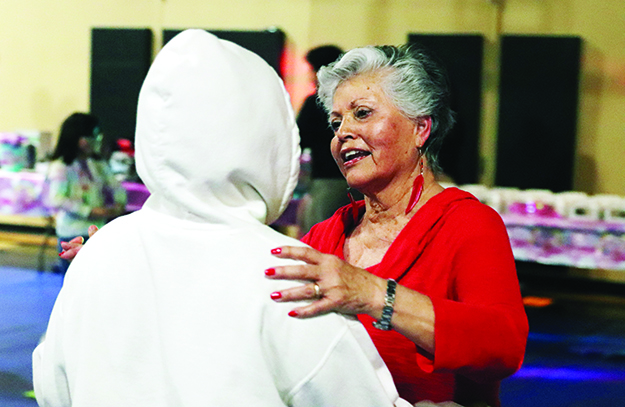
By Kalvin Valdillez, Tulalip News
The lights were dim, and the music was bumping at the Greg Williams Court on the evening of February 14. Multi-colored strobe lights danced about the room in perfect sync with the music, and added to the aesthetic of both romance and good times on Valentine’s Day this year.
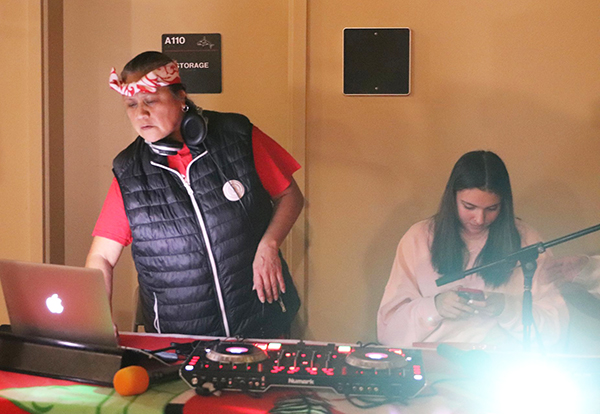
Tables were stationed around a large space that served as a dancefloor at the head of the gym. While the one and only DJ Monie set the vibes at the start of the evening, families and couples slowly trickled in; some grabbed a plate first, while others lined up at the popcorn and balloon animal lines. And before anyone even knew it, the place was packed, and laughter was shared by all deadly aunties and uncles alike.
This celebration on the National Day of Love was the first of its kind at Tulalip and was a big success. Hosted by the Tribe’s Education Division, the Community Valentine’s Day Dance had well over one hundred people in attendance, many of whom danced the night away.
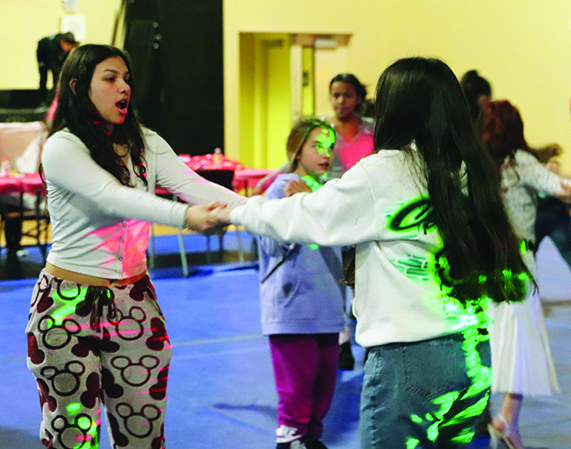
“I danced the entire time,” exclaimed Tulalip youth, Tashina Cortez. “There was Cupid’s Shuffle, Cotton Eye Joe, and I really liked Uptown Funk and the Cha-Cha Slide. I thought this was going to be a regular Valentine’s Day, exchange gifts with classmates and go home. But then I found out it was a dance, and it started getting really fun when people actually started to dance.”
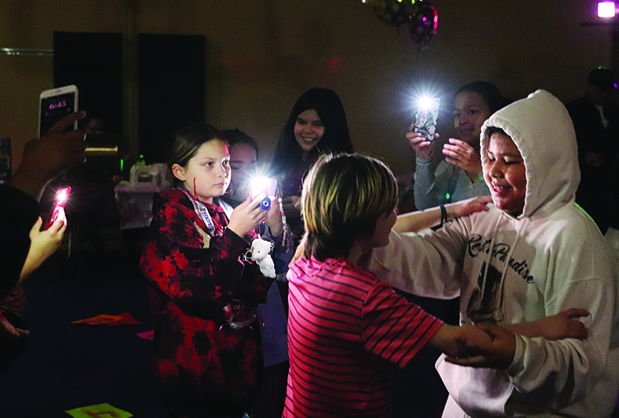
Love birds, parents and children, cousins, and best friends showcased their affection for one another by spending some time and sharing a dance together during the Valentine’s Day gathering. In addition to dancing, there were various activities, including a cake walk and a door prize raffle.
The life of the party was a group of local elders who didn’t miss a step or leave the dancefloor for the duration of the three-hour event. A highlight for many was when a young man and a tribal elder broke the age barrier and joined together in a slow dance while a group of teens circled around them and swayed their phone flashlights back and forth, reminiscent of lighters at a rock concert. And just like that, tribal elders were on the floor with the teens learning how to do the stanky leg, the superman, and the nae nae.

“We haven’t hosted an all-ages community dance in a long time, so that was really cool to see everyone excited about it,” said Executive Director of the Tulalip Education Division, Jessica Bustad. “It was awesome. It felt so good to see our community in a space together like that, for something positive and for everyone to just have fun. Add to the fact that there were little people all the way to elders dancing, and the elders even outlasted some of the adults!”
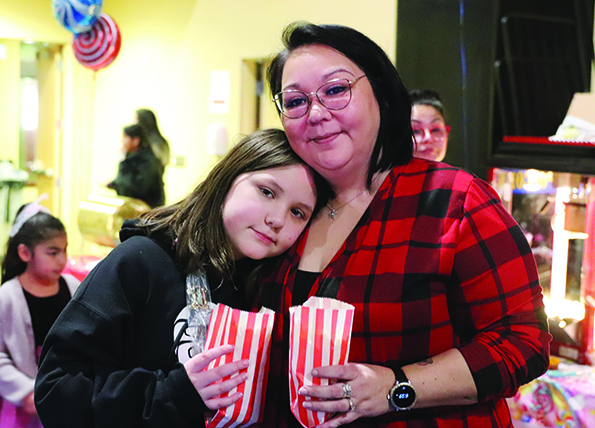
This year, February 14th was also Election Day. And as you may know, the Tulalip Education Division was a strong advocate for the levy on this year’s special election ballot, which affects Tulalip students who attend school within the Marysville School District. Hoping to garner as many yes votes as possible before the 8:00 p.m. deadline, the Education Division took time throughout the dance to remind all eligible voters in attendance to cast their vote.
Jessica expressed, “Hopefully the levy passes, but aside from the levy, we still have to keep coming together as a community in a positive way to show our children that we can live in a healthy community together.”
Dean Fryberg Sr.
January 22, 1945 – February 11, 2023
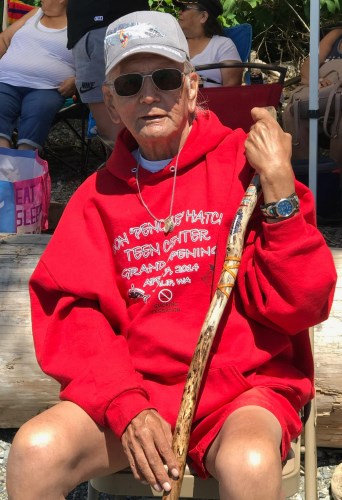
Dean Fryberg Sr. Jee-Leets-Kynum a member of the Tulalip Tribes passed away on February 11, 2023. He was born January 22, 1945 in Everett WA. He lived his life in Tulalip, Washington.
Dean had a great love for his family, tribal community, and for the lands he was born and raised. He loved walking the beaches and picking up eagle feathers as long as he was able to.
Dean was a stellar athlete, he was a member of the Tulalip Renegades and Tulalip Chiefs. He excelled at Tulalip hardball as a second baseman, basketball where he was known as “Youngblood” by everyone on the native circuit. He played with precision and great talent, carried a lot of love for the game. Dean also was an avid Seattle Seahawks fan. He traveled to San Francisco with his brother Clarence for boxing.
Dean enjoyed participating in the Paddle to Seattle in 1989 with his brothers, and then to Victoria, BC with his Fryberg family in 1994 for the Commonwealth Games. He continued to pull canoe for as long as he could. His last pull was the 20th anniversary of Paddle to Seattle in Suquamish in 2009.
Dean was a logger, commercial fisherman, Fish Patrol Officer and a welder at the Tulalip Maintenance shop for many years. He enjoyed pole fishing, pool league, hunting, Sr Bingo, and the Casino with LaDonna. Dean’s love for his family was absolute.
He leaves behind his children: Dean Fryberg Jr, Jimmy Fryberg, Timmy (Lynn) Fryberg, Robert Fryberg, Loris Fryberg, Stephanie Fryberg and special daughter Lahneen Fasthorse. Dean leaves behind his siblings: Billy (Sharleen) Fryberg, Cy (Karen) Fryberg Sr, Jeanette Fryberg, and special brother Pete (Bonnie) Jerry and grandchildren he raised Dereka, LaDwena, William, Chiefy and LaDonna. Along with 23 grandchildren, 37 great-grandchildren.
Dean is preceded in death by his parents Martin & Josephine Fryberg; Wife LaDonna Fryberg; Brothers Clarence Hatch Sr, Myron Fryberg Sr, Byron Fryberg Sr, LeRoy Fryberg Sr, Gerald Fryberg Sr, Marlin Fryberg Sr and baby sister Josephine Fryberg. Son Hanford James Sr, and grandchildren Jennifer Fryberg and James (J.D.) Fryberg.
A service for Dean will be Friday, February 17, 2023 at 10:00am at the Tulalip Gathering Hall, 7512 Totem Beach Road, Tulalip, WA 98271. Dean will be laid to rest following service at Mission Beach Cemetery in Tulalip.
Heritage boys have strong showing at Districts

By Micheal Rios, Tulalip News
Led by a new coaching staff, with head coach Malcom Mack at the helm, the Tulalip Heritage boys basketball team soared to a (7-0) record to open the ’22–’23 season.
It wasn’t until early January that they finally played legit inner-league competition in rivals Grace Academy and Lummi Nation. Those two teams proved to be too much for the Hawks, who couldn’t match the physicality and tempo of their rivals for a full four quarters. Heritage went (0-4) versus the cream of the Northwest 1B crop.
Fast forward to the end of January and the Hawks were riding a losing streak, with one no-contest vs. Fellowship Christian because of an on-court scuffle, to conclude the regular season. On the morning of February 1, both players and coaches woke up with an overall (12-6) record, which was good enough for the 3rd best team in the Northwest 1B division. However, they also knew they’d be without a couple starters for multiple games because of post-scuffle suspensions and consequences from accumulating too many technical fouls.

Shortly thereafter the 2023 District Tournament bracket was released and the #5 seeded Hawks drew a team in Providence Classical Christian that they had defeated twice by 30+ points during the regular season. This fact gave the coaching staff confidence their squad would still be victorious even being down a couple key contributors.
Tulalip hosted Providence at Francy J. Sheldon gymnasium on February 2. The Hawks came out playing well on both ends of the court. After taking an early 12-3 lead, they extended that to 15 points midway in the 3rd quarter when they led 40-25 in front of their emphatic fans. Then things got really interesting.
Providence didn’t sulk, nor let their bench players stay in. Instead, the away team left their starters in the whole 4th quarter and they battled back to create a real sense of urgency in the Hawks who had led big for most of the game. Tulalip didn’t help matters by going nearly 8 minutes of game play without scoring a point. With under 4-mintues to go, Tulalip’s big lead had been whittled down to just four points, 40-36. Tarynn Fryberg finally ended his team’s scoreless run with a must needed bucket and made free-throw, which ended up being the difference as the Hawks would hold on to muster a 46-40 win.
Two days later Heritage played rival Grace Academy, in their house, and caught a quick and decisive L. The boys couldn’t hang their head for long following the 37-61 loss because they were scheduled for a loser-out game just 48-hours later.
On February 7, once again at Francy J. Sheldon gymnasium, the Hawks hosted Shoreline Christian. Tulalip had bested Shoreline during both regular season matchups, but that didn’t deter Shoreline from bringing the heat the third time around. The home team struggled mightily offensively in the first quarter to the tune of trailing 2-13. Coach Mack and his assistants must’ve lit quite a fire under the boys because after battling back to make it 24-29 at the halftime, the Hawks shooters ignited an offensive explosion in the 2nd half. After only putting up 24 points the entire 1st half, they put up a whopping 44 points over the 3rd and 4th quarters to pull out an impressive 68-56 come from behind victory.

With the latest win came a chance to place at Districts and secure a spot in the Tri-District Tournament. All they’d have to do is get one more win against their opponent Lopez Island Lobos in their matchup played at Mount Vernon Christian High School on February 9. The Tulalip faithful travelled well for this away game and did their best to bring high energy fandom from the bleachers.
Those in attendance were treated to a back and forth, entertaining game between two teams desperate for a win. Tulalip jumped out to an early 12-5 lead, but was plagued by turnovers committed against a Lopez full court trap that resulted in easy transition buckets for the Lobos. With senior guard Louie Gallagher on the bench, the Hawks offense continued to sputter and eventually found themselves trailing 17-20 midway in the 2nd quarter.
After Louie was reinserted back into the game, he’s intensity on both ends of the courts became contagious as his fellow Hawks began jumping passing lanes and running the floor at a near frantic pace…Rez ball at it’s finest.
After leading 31-25 at halftime, Louie and senior forward Nicholas Rhoads did their best to put away the Lobos with timely passing and interior scoring. Louie even had a chasedown block that sent the Hawks fans into a frenzy. The team fed off that energy and continued to run at every opportunity, eventually pushing their lead to 20 points at 61-41. Tulalip never lifted the throttle and wound up with a huge 80-43 win. Senior players Louis Gallagher scored 27 points and Nicholas Rhoads added 20 points to lead their team.
The crowd pleasing win secured a 5th place finish for the Hawks at Districts and punched their ticket to the Tri-District Tournament.

It was a tough draw for the home team as they were seeded #11 and had to travel to Orcas Island to play a team that had beaten both Grace and Lummi, both teams Tulalip had struggled against all season. It would indeed be an uphill battle versus an overall better team as the Hawks season ended abruptly with a 71-88 loss on February 11.
“Overall, it was a good season filled with a lot of team dubs,” shared guard Louie Gallagher. “There were times we trailed in games and had to calm down and come back together as a team with the right energy. Those were the most fun games to me when we showed our ability to refocus against a good team and come back to win by a lot. I loved the support the Tulalip community showed me and my brother Blaine and the entire team all season long, whether it was at home games or traveling to watch our away games. Thank you, Tulalip.”
February 11, 2023 syəcəb
Please use the following link to download the February 11, 2023 issue of the syəcəb
Saturdays are for Storytelling
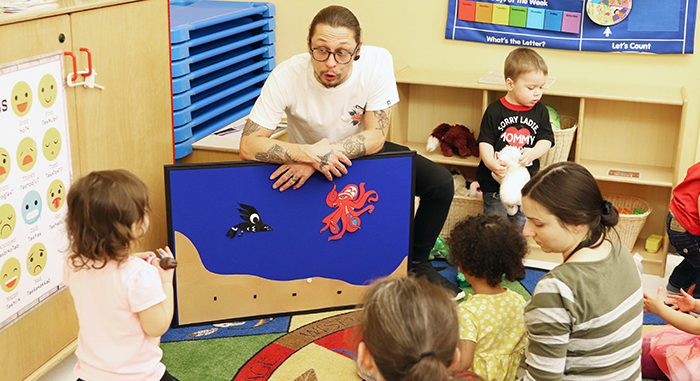
By Kalvin Valdillez, Tulalip News
The traditional language of the sduhubš is strong within the Tulalip community. And it is apparent that with each passing year, Lushootseed continues to grow stronger as more and more of the tribe’s membership develops a connection to the language of their ancestors.
Thanks to a partnership between the Lushootseed department and the Betty J. Taylor Early Learning Academy, the language is introduced to the academy’s students as soon as they are enrolled in their birth-to-three program. Lushootseed is now often present throughout a tribal member’s academic career, from early head start all the way to college, as the Lushootseed Language Warriors hold classes at local schools to impart their tribe’s ancestral teachings to the future of Tulalip.
In addition to teaching the language at schools, the Lushootseed department does an excellent job at extending their lessons to the entire community by offering classes, both online and in-person, every year. They also make it a priority to ensure the language is accessible at all times for their people, with the development of a fun digital app, an engaging and informative website, and by hosting a handful of community events. And now, the Lushootseed department is taking over Saturdays by dedicating one hour of storytelling to the community over the next several weeks.
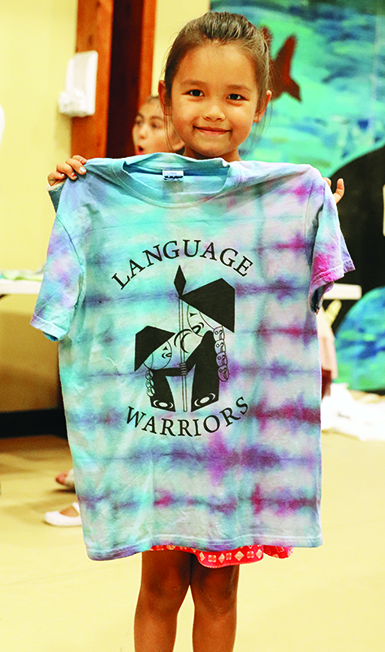
Said Lushootseed Department Manager, Michele Balagot, “Most of our Lushootseed classes are all tied into stories. That’s where you learn how to do the grammar and get the teachings from each story. Toby Langen (Lushootseed Revivalist), that’s how she taught us, was through stories. I was thinking of different ways that we could get the language out there, and I thought why don’t we just do stories, here in person, that’s how we used to do it back in the day anyway.”
The first storytelling gathering was held on February 4th, where Lushootseed Warriors, Natosha Gobin, Thomas Williams, and Kylee Sohappy kicked-off the weekly get-together and shared a few traditional stories with a number of Tulalip families.
Throughout the duration of the global pandemic, the Lushootseed department brought their lessons to the world wide web by hosting classes on Zoom, and they received a great response from the people during the mandatory stay-at-home order. After seeing the success of the online classes, the Lushootseed Department decided to livestream the storytelling gatherings for those who are unable to attend in person. And if the first event serves as an indication of how many people the department can reach online, the remainder of the classes are sure to be a hit, as that livestream garnered close to 1k views, as well as numerous interactions, comments, and shares.
“These gatherings also help our teachers, so they’re more comfortable telling stories,” Michele expressed. “Everyone was excited about this, but we do have some teachers who are new and have never told a story in front of people before, so they were a little nervous. One of them was Kylee, and I heard she did a great job with her story.”
“I told Her First Gift Basket,” Kylee beamed with pride. “It was a story from Vi Hilbert, retold by Michele Balagot, and illustrated by Michelle Myles. It’s one of our first hard book cover copies that was published, and we’re hoping to publish more by the end of the year.”
She continued, “I was excited to be a part of our first gathering with the community, so others can become familiar with the language, because it’s an important thing to pass on to everybody in the community.”
The classes are held at the Lushootseed department, inside the library of the old Tulalip elementary school. With many Lushootseed Warriors on their team, Michele explained that the language instructors will rotate storytelling duties throughout the coming weeks. And since the gatherings are held on the weekend, Michele left it to the discretion of the Warriors to choose a time that works best with their schedule outside of work.
So be on the lookout for flyers, e-mails, and social posts as the storytellers of the week will be sharing the details of when the gathering will take place, and where you can catch the livestream. And you better believe that the Lushootseed department has much more planned for 2023, be sure to stay tuned to the syəcəb and Tulalip News as they reveal their upcoming happenings. And as always, do yourself the favor of checking out their website, www.TulalipLushootseed.com, which is updated frequently and beautifully showcases the lifeways of the Tulalip people, and shares much of their ancestral teachings.
“We’re trying to reach anybody who wants to hear a story,” shared Michele. “We encourage families to come because you can learn together with your child and then you can speak it in your home, that’s what we aim for.
“I hope this gets more people interested in learning our language and learning the stories from our ancestors. We need more people involved, so we’re trying to get the language out there any way we can. And if anybody has any suggestions about what they would like to see or like us to do, then send me an e-mail (mbalagot@tulaliptribes-nsn.gov) and we will consider it.”
Pallet shelter offers ‘a new beginning’ for Tulalip homeless
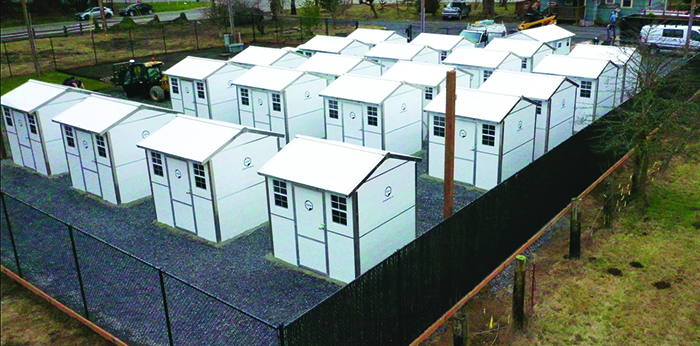
By Micheal Rios, Tulalip News
Back in 2018, Tulalip leadership issued a declaration of emergency regarding the opioid epidemic. Under this declaration all tribal agencies and departments were able to make the opioid epidemic a priority and, when given opportunity, collaborate to develop solutions.
It took ample time and much well thought-out, strategic planning to get here, and now Tulalip has debuted several all new services including the Village of Hope, transitional units, the Recovery Resource Center, and a medical assisted treatment clinic. On Monday, February 6, in an excitement-filled grand opening of a much-needed service for Tulalip’s growing homeless population, the Tribe formally opened a pallet shelter.
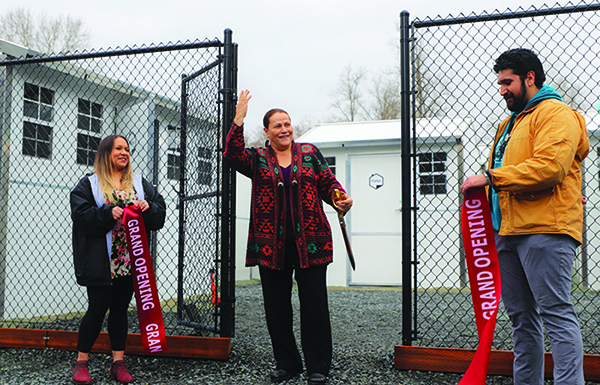
“This means the difference between life and death for some of our people,” said Chairwoman Teri Gobin. “Bringing twenty new units here to take care of our people, and also offer additional services from so many amazing staff who are dedicated to healing our community. We have debuted so many resources within the last year to help our people who suffer from addiction and homelessness. We hope these pallet shelters offer a new beginning step for those who need it most as we continue to work towards supporting each and every one of our members in their pursuit of a healthy lifestyle.”
There’s a strong correlation between homelessness and drug use. In fact, it’s estimated that about two-thirds of the perpetual homeless have a primary substance use disorder or other chronic health condition, according to the Office of National Drug Control Policy.
While average rent costs in the greater Tulalip/Marsyville area continue to rise, plus the simple fact that homes on the reservation are extremely difficult to come by, it becomes a pressing social issue to offer some kind of housing solution, however temporary, in order to minimize the risk of tribal members giving into drugs as a means to escape a seemingly perilous homeless situation.

Since Tulalip’s 2018 declaration, the opioid crisis has only gotten worse. The number of fentanyl-based overdoses and deaths in our community continues to go up, making it imperative that Tulalip makes strides to help our people find their good way.
“It’s imperative we find culturally-relevant solutions and quickly because we’re losing so many of our people, especially our young ones, to fentanyl,” said Chairwoman Gobin. “It’s heartbreaking to think of how many homeless we have sleeping outside in freezing conditions. This pallet shelter provides an alternative solution to be warm, indoors with electricity and, even more than that, a sense of community knowing we haven’t given up on our people.
“For those that are homeless and suffering from addiction, the pallet shelter will also offer services like entry into a detox program and admission to the MAT clinic in order to get them on the road to recovery.”
The pallet shelter is the result of a newly development partnership with local, Everett-based company Pallet. Their steadfast team built all the individual units on-site in Tulalip in just two days, with their deployment just so happening to occur during the latest snow storm.
Pallet shelters provide the dignity of private space in a healing community environment. They are a proven community solution, built fast and at scale.

“This is a special moment for us as it marks our 100th village build,” shared Amy King, CEA and founder of Pallet. “My husband and I started this company seven years ago in a local shop as a way to provide jobs for people exiting homelessness, addiction recovery programs, and the state’s justice program. Today, we are in 76 cities and 21 states across the country. This build is especially meaningful because its so powerful, helpful and exciting to be part of building [potential lifelines] in our local community.
“This location holds special meaning for some Pallet employees who previously experienced homelessness in the area and are now finding purpose in building transitional housing to help others in the community,” she added.
As stated previously, the pallet community is made-up of twenty 64-square-foot shelters. Each designed and built with the right balance of efficiency and comfort, including climate-control options.

Over the years, Tulalip News has covered extensively the rise of tiny homes and openings of tiny home villages as an impactful means of minimizing homelessness. With special shutout to the on-reservation TERO Vocational Training Center that has churned out wood-based tiny homes for villages in Olympia, Seattle and Tulalip. That being said, these units created by Pallet are next level.
Durable – Pallet shelters are made to last with a 10+ material year lifespan. They’re resistant to mold, rot, and pests, and can be easily cleaned as one resident moves out and another moves in.
Comfortable – Insulated walls, heat, and air conditioning provide personal climate control, and electricity powers the interior lights and outlets for personal device charging. Spacious with 9-foot vaulted ceilings.
Rapid – Made of prefabricated panels that are flat-packed for shipping at scale, each cabin can be assembled in under an hour with minimal tools. Shelters can be disassembled for flat storage or reuse.
Cost-effective – Pallet offers a cost-effective price point because they use fiberglass reinforced plastic with a foam insulating core for the panels and shelves. Plus, they use aluminum framing.
Safe – Each shelter comes with a smoke detector, carbon monoxide monitor, egress door, and fire extinguisher. Shelter villages are independently inspected by local fire inspectors to ensure adherence to local fire safety code requirements.
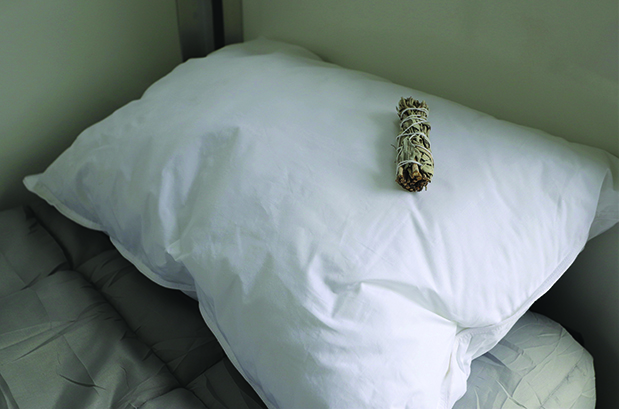
The pallet shelter’s grand opening marks Tulalip’s latest endeavor as part of a multi-department, tribally coordinated opioid crisis response. This response aims to address service gaps including the need for increased community outreach, education and engagement in order to expand present prevention and intervention efforts.
“This is a real special day for us in Tulalip,” affirmed CAO Rochelle Lubbers. “I especially want to thank our Board of Directors for guiding us in this direction and creating that vision for us that no Tulalip tribal member will ever be left behind. Every single tribal member matters and we will be here to support our people no matter where they are on their journey. Today, the pallet shelter is an important step towards making that vision a reality because it provides low-barrier access to critical services, which is a huge stepping stone to long-term recovery.
“Our goal is to truly help and provide necessary assistance to those folks in the Tulalip Tribes who are homeless and experiencing addiction,” continued Rochelle. “These pallets represent not just long-term recovery to residents, but to our whole community. The people who will be residing here are our brothers and sisters, sons and daughters, mothers and fathers. We believe that the pallet shelter offers us a chance to heal people, and for every person healed we heal an entire family.”
The easiest way to gain access to a pallet shelter unit located off the intersection of Marine Drive and 19th Avenue is to stop by its main office, the green house out front, during business days and ask for an application. Another way is to stop by the new Recovery Resource Center and speak to staff who also oversee the pallets that can provide more information.
Quil Ceda Creek Counseling opens its doors
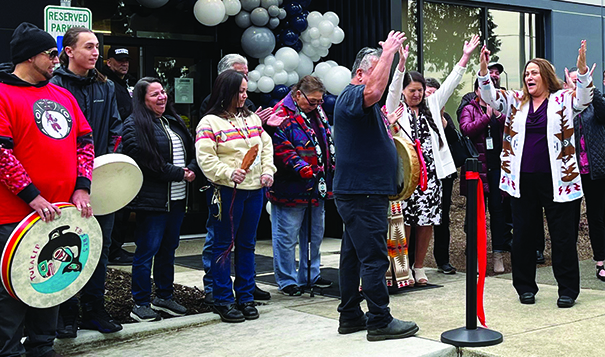
By Shaelyn Smead
On February 3rd, Quil Ceda Creek Counseling (QCCC) held its ribbon-cutting ceremony, welcoming everyone to tour the facility and view all the resources available to patients seeking recovery from opioid addiction.
At the opening, Tulalip Vice Chair Misty Napeahi said, “This project has taken about five years to complete. I want to thank former board members Les Parks and Jared Parks for bringing this to the table when the tribe was against methadone. With greater understanding and more learning about harm reduction, we are here today and get to save lives… Many of our tribal members and young people are falling into addiction, and because of this [QCCC], they have a way to get their life back. Our family, community and tribal members are suffering, and their lives matter.”
Tulalip tribal member and QCCC Clinic Administrator Tanya Burns said, “This will be a drop in the bucket, but it is also necessary for this community and others. It takes a village, and we are blessed to have such wonderful staff members who are passionate and committed to helping save lives.”
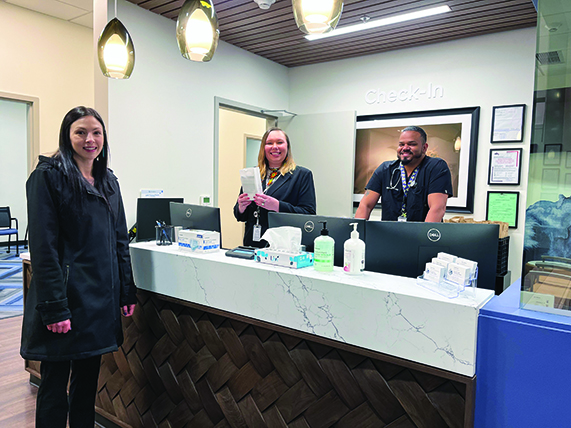
The QCCC is set to serve 150 patients at any given moment and provides various services, including substance use disorder (SUD) consultations, SUD assessments, individual SUD appointments, individual treatment planning, SUD outpatient groups, medical and mental health assessments, and referrals to other community resources. The program’s three phases are induction, stabilization, and maintenance, a system designed to mitigate a patient’s chemical dependency and help them regain control of their life. While using these resources, patients must maintain confidentiality, follow their treatment plan’s urinalysis and breathalyzer guidelines, and obey the treatment team contract.
The purpose of group treatment and mental health assessments is to help pinpoint any possible traumas that may have influenced their life and snowballed into their addiction. Group treatment also provides information to patients new in recovery, allowing them to build a community within the program and facilitate personal growth.
In a media release Tanya stated “A lot of the folks that will come in here will have co-occurring disorders. They may have a substance use disorder which can be fairly obvious on the outside. However, they may also have a mental health disorder or something else. We want to treat the whole person.”
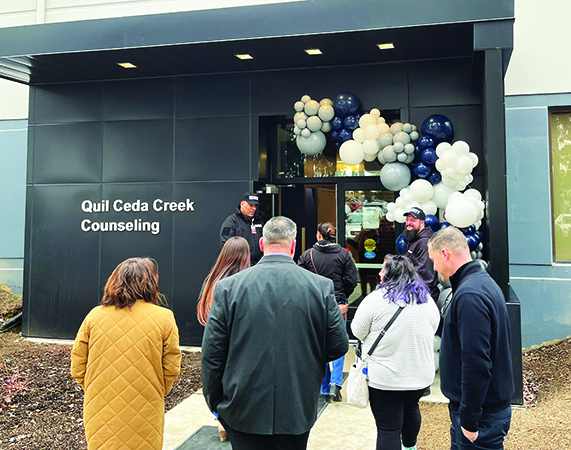
QCCC did receive their DEA approval and will also provide medication for SUD, such as methadone, Suboxone, and Vivitrol starting February 27th, 2023. However, clinic staff advises that any prospective patients begin their intake sooner rather than later to avoid pushing out their treatment plan. SUD professional Elissa Jules stated that intake can take around three weeks to process and approve a patient. She added that patients can still use the other program resources and courtesy dose while they wait for their medications through QCCC.
While receiving services or dosing, patients can leave their children in the playroom area, where they will be taken care of until the patient is finished. The facility does contain robust security and procedures ensuring the safety of its clients, children, and staff.
Even though addiction treatments like methadone, Suboxone, and Vivitrol have remained quite a controversial topic amongst many, staff on the ground argue that this is the most effective path for recovering patients. Elissa said, “When I first started, I wasn’t big on [patients using] methadone either. I know there is a stigma towards it, and people believe that methadone is replacing heroin or fentanyl, but that couldn’t be more false. Methadone doesn’t get you high, it blocks patients from the euphoric effects of opioid use. It is a harm reduction program, and we administer these medications and techniques to debilitate opioid use. I’ve seen it be successful for many people.”
The opioid epidemic has affected many communities and families across America. In our area alone, according to Snohomish County, in 2022, over 345 Snohomish County residents overdosed. And drug-related overdoses remain the leading cause of death within Tulalip Tribes. With many health professionals and community leaders working together to fight this epidemic, medications like methadone and Suboxone have made strides in these efforts.

Elissa previously worked at Lummi and the didgwalic Wellness Center of Swinomish before coming to Tulalip. She has seen the effects of opioid addiction within Native communities firsthand. “I’ve seen opioid addiction spread heavily across tribes. Overdoses have increased tremendously in the last ten years of working in this field. We’re losing a lot of our Native people, and every time someone is an addict, they lose their connection to their culture, whether in the church or the longhouse. The more addicts and deaths we have in our community, the harder it is the hold on to our culture. Sometimes I see patients as young as 12 years old using methamphetamines or have tried opioids, and it’s scary.”
The QCCC is an excellent resource for addicts ready to take that next step. It is open to tribal and non-tribal members, and referrals are not required. Operating hours for the facility will be M-F 6:00 a.m. to 2:00 p.m., Saturday 6:00 a.m. -10:00 a.m., and closed on Sundays. It solely serves on a first-come-first-serve basis to avoid long waiting periods and adhere to the needs of patients more quickly. However, tribal members and pregnant women do take priority. For more information about the services, please call 360-716-2200 or drop in at 6330 31st Ave NE, Suite 101, Tulalip, WA 98271.